Grasshoppers have fascinated us for many decades. Their different coloration, mating rituals, and hoping abilities always captured our attention.
Grasshoppers vary in coloration and patterns all over the body. But have you wondered about black and yellow grasshoppers?
In this article, you get to know about these 14 beautiful black and yellow grasshoppers.
14 Beautiful Black And Yellow Grasshoppers
1. Western Horse Lubber Grasshopper
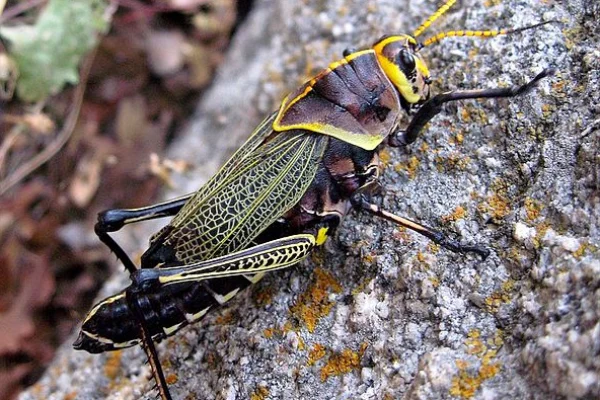
| Scientific name | Taeniopoda eques |
| Size | 7cm |
| Location | Southwestern United States and Northern Mexico |
| Identification | Black and yellow-patterned forewings |
Taeniopoda eques is one of the largest species of grasshoppers of the family Romaleidae found in arid regions of the United States.
The body of this flightless grasshopper is mostly black and has remarkable black and yellow patterns over the forewings and orangish antennae.
Stridulation is very common in males, and their size varies from habitat to habitat.
They are opportunistic carnivores; sometimes cannibalism is also seen in this species.
2. Elegant Grasshopper
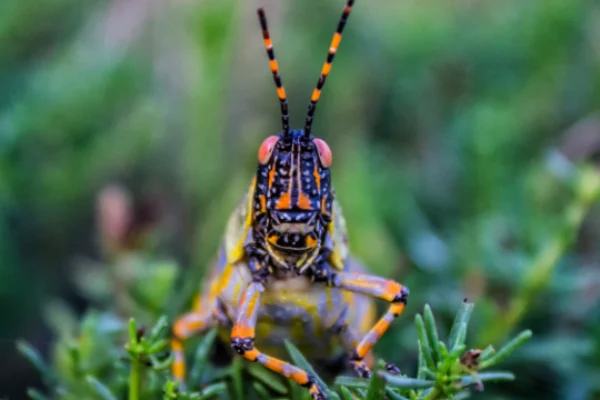
| Scientific name | Zonocerus elegans |
| Size | 3.2-5.1 cm |
| Location | Southern, east central, and East Africa, also in Madagascar |
| Identification | Have yellow and black abdominal rings |
Known as Elegant Grasshopper due to its distinctive appearance and gracefulness.
The adults of this species have green bodies with black and orange markings and also have black and yellow abdomen rings.
It’s an important cassava pest. This striking coloration of this grasshopper species warns the predators that they are poisonous and not worth eating.
3. Eastern Lubber Grasshopper
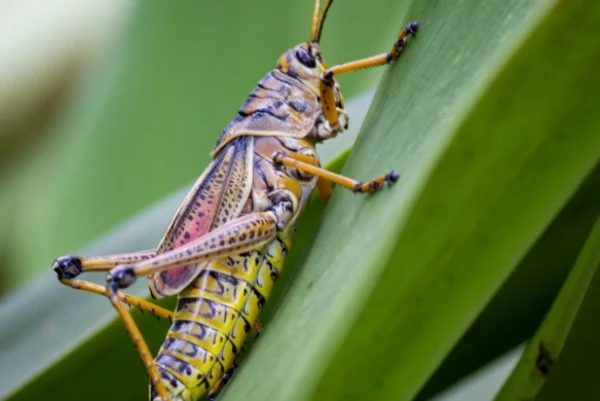
| Scientific name | Romalea microptera |
| Size | 64-76 mm |
| Location | Southeastern and south-central United States |
| Identification | Black body with yellow markings OR orange body with black markings |
This southeastern United States grasshopper species is very well known because of its unique coloration and size.
They have a yellow-orange body with different black patterns, which make them unique.
This weedy, vegetation-inhabited species is also famous for its defense strategies.
We talked about coloration in the previous article; apart from that, they secrete foamy, foul-smelling secretions when they feel threatened, making the predators feel that they will not be tasty.
4. White-lined bird grasshopper
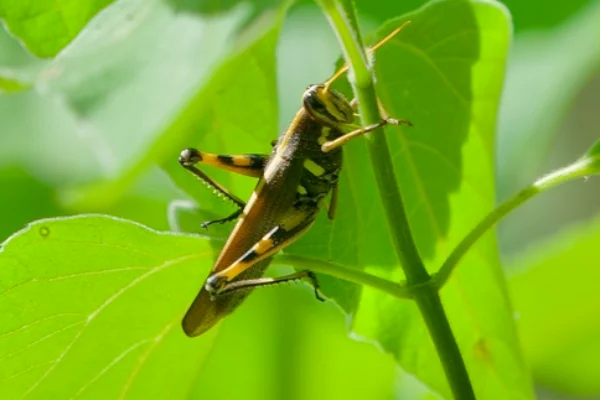
| Scientific name | Schistocerca albolineata |
| Size | Up-to 5 cm |
| Location | Texas, Mexico, and Arizona |
| Identification | Brown to black body with pale yellow markings |
This species is found near the US-Mexico border. They are known as bird grasshoppers due to their long, slender bodies that resemble those of birds.
This species is dark olive to black with pale yellowish markings.
They are quite active; one can find them hopping here and there in their native area.
They are not considered pests but sometimes become a nuisance when present in large numbers.
5. Painted Grasshopper
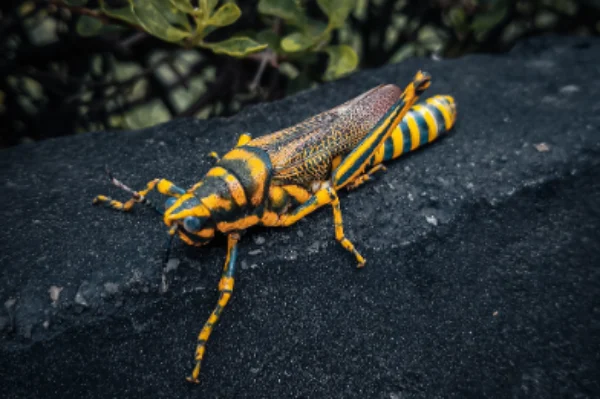
| Scientific name | Poekilocerus pictus |
| Size | 60mm |
| Location | Indian subcontinent |
| Identification | Greenish-yellow body with fine black and indigo markings |
This grasshopper species, also known as the Aak grasshopper or titighodo, is likely to be fed on milkweeds.
This painted grasshopper species of size 60mm is commonly found in the Indian subcontinent, and they are well known for their distinctive appearance.
Talking about appearance, they have a green-yellowish body with astonishing black and turquoise markings and black and yellow antennae.
They change their appearance when molting.
6. Spotted Grasshopper
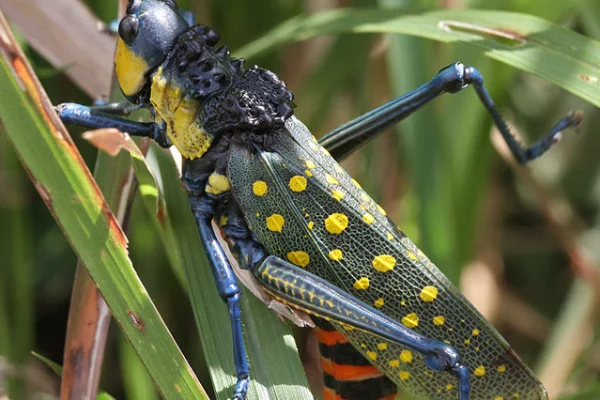
| Scientific name | Aularches miliaris |
| Size | 35-52 mm |
| Location | Indian subcontinent |
| Identification | Green tegmina with many yellow spots |
This endangered species native to the Indian subcontinent is considered a pest in agricultural areas.
They have distinctive green forewings with yellow spots. Their abdomen is black with bright red bands.
It stridulates from its thoracic segments. They also have some defense strategies, like cryptic coloration and the ejection of toxic forms when they feel threatened.
7. Black-Winged Grasshopper
| Scientific name | Dissortetra Carolina |
| Size | 32-58 mm |
| Location | North America |
| Identification | Inner black wings with pale yellow and white margins |
This North American species of grasshopper is one of the largest species, ranging in length from 32 to 58 mm.
They have a brownish body with spectacular black wings with yellow-whitish margins.
It is often mistaken as a butterfly due to its size and lazy, bobbing flight.
Research shows that they are thermophilic. They are widely distributed in the area of weeds and vegetation.
8. Australian Yellow Zebra Grasshopper
| Scientific name | Zebratula flavonigra |
| Size | 2 inches |
| Location | Australia |
| Identification | Have striking yellow and black stripes like zebra |
As the name indicates, they have a zebra-like appearance in different colors.
They have black and yellow stripes all over the body. This large grasshopper of size 2 inches is native to Australia and inhabits forests, grasslands, and deserts.
Their striped appearance is thought to be a form of disruptive coloration.
It means they can fool the predators, as their stripes can hide their outline and make it difficult to trace their movements.
9. Differential Grasshopper
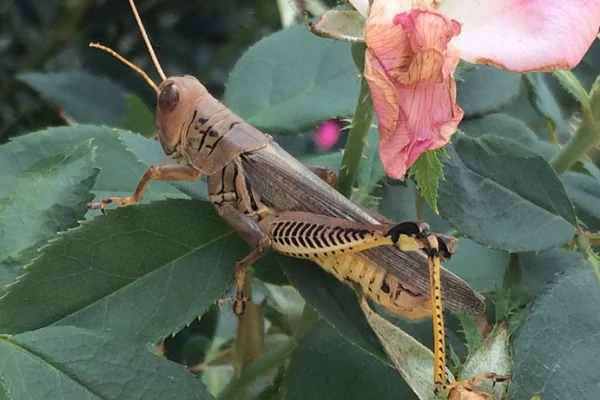
| Scientific name | Melanoplus differentialis |
| Size | 28 – 50 mm |
| Location | United States |
| Identification | Yellow body with black grooves |
This pest of alfalfa and hay crops is considered a serious threat to farmers in several areas of the United States.
They have characteristic chevron or herringbone patterns on their hind limbs.
They have brownish or green bodies or can be yellow, with black grooves on the pronotum.
Females are comparatively larger than males. Males range from 28–37 mm, and females have a size range of 34–50 mm.
10. Two Striped Grasshopper
| Scientific name | Melanoplus bivittatus |
| Size | 30-55 mm |
| Location | North America |
| Identification | Two pale yellow whitish strips |
Known as two-striped grasshoppers due to the presence of two yellow-whitish strips that run along the greenish body and also have black wings. They are considered one of the major pests in the agricultural industry.
They damage crops throughout their life cycle. Not only leaves but also reproductive parts like stamens, pistils, etc. They have to pass through 5 instars stages to reach the adult stage.
Get their color due to the presence of chromoprotein and carotenoids. This species is known to cannibalize each other in the shortage of food.
11. Desert locust
| Scientific name | Schistocerca gregaria |
| Size | 7–8 cm |
| Location | Northern and eastern Africa, Arabia, and southwest Asia |
| Identification | have a bright yellow body with black blotches on their wings |
As their name implies, they are found in deserts and dry areas of northern and eastern Africa, Arabia, and southwest Asia.
As you can see clearly in the image, they are yellow in color with grayish wings and black blotches on them.
These species also exhibit polyphenism, which manifests itself in a variety of ways based on the environment in which it lives.
They may travel considerable distances and do significant damage to crops, producing nuisances.
12. Migratory locust
| Scientific name | Locusta migratoria |
| Size | 35 to 55 mm |
| Location | Africa, Europe, Asia, Australia and New Zealand |
| Identification | Have yellow body with green head |
You can find this species all around the world, including in Africa, Europe, Asia, Australia and New Zealand.
They vary in size and color depending on their phase, which is assumed to be governed by DNA methylation.
They pose a serious risk to farmers and were implicated in the 1928 African plague outbreak.
Apart from creating nuisances, they are also used as food in Europe, especially Switzerland.
In their solitary phase, their head turns green with black blotches on their wings and a yellow body.
13. Marsh meadow grasshopper
| Scientific name | Chorthippus curtipennis |
| Size | 12 to 35 mm |
| Location | Northern United states and Canada |
| Identification | Have a yellow abdomen with black blotches |
These marsh meadow grasshoppers are found on tall grasses in moist regions of both Canada and the United States.
Wings are not as long as you see in other species.
Have yellow legs with a little greenish tone and black joints. When you look at their abdomen, it’s yellow with black bands.
Feeds on various grasses and sedges, such as bluejoint, timothy, and cattail.
The exact location inside the marsh meadow grasshopper’s range determines how long it will live.
14. Field Grasshopper
| Scientific name | Chorthippus brunneus |
| Size | 15 to 25 mm |
| Location | Europe, north Africa, and temperate Asia |
| Identification | Have brownish wings with bright yellow abdomen |
The hue of Clorthippus brunneus varies greatly, ranging from black to white.
Their abdomen is a vivid yellow color, and their wings are brownish with black dots.
These herbivorous and polyphagous grasshoppers are commonly found in the Western Palearctic region, from Europe to Asia.
Males usually produce sound in order to attract females, which females produce back if they are interested. It’s interesting, isn’t it?
They are univoltine, which means they produce only one generation in one year.
Conclusion
In conclusion, we can say that these beautiful black and yellow grasshoppers are quite common in many areas on Earth.
They are known for their distinctive coloration. They are herbivores and are considered pests on many crop species.
But they are important to the ecosystem as well as they help to control the growth of certain weed species.
In all, these black and yellow grasshoppers are fascinating creatures with astonishing colorations and very well adapted to their surroundings.
If you see a black and yellow grasshopper in your surroundings, be sure to admire its enchanting markings.
Also Read:

Being a zoology student I’m always been fascinated toward animals especially insects. I love to do research and learn about different animals. As a writer I want to share my thoughts about nature through my articles. Apart from this you can find me exploring the new places and voice notes.
